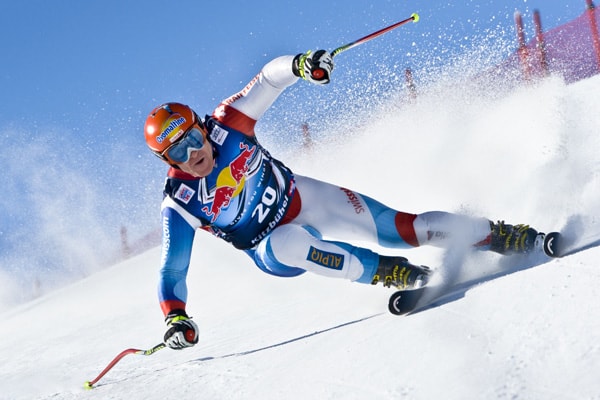
Dr Michael Huber, President of the Kitzbuhel Ski Club (KSC), is a man with a lot on his mind. And no wonder – because he’s in charge of the most famous ski race in the world: the Kitzbuhel Downhill, part of the Hahnenkamm race weekend. It has to be one of the most high-pressure jobs in skiing.
A key part of his work is to oversee the preparation of the terrifying and vertiginous course down which the skiers race. He and his colleague Barbara Thaler took time out from their pre-race schedule to share some of the secrets behind this extraordinary strip of snow.
1. You’ve Gotta Have Goats

That’s right. Goats. Work on the Kitzbuhel downhill course (called the Streif) is a year-round process, and in summer, it needs to be grazed – so that when autumn comes, it’s not covered in shrubs and bushes. Problem is, in places the Streif is too steep for cows; so they use goats instead. Actually, a few stretches are too steep for goats, too: notably the Mausefall – a jump at the start of the course which has an 85% gradient, and is mown by humans. Not with a Flymo of course (imagine trying to mow grass on an 85% gradient). They use scythes.
2. You need the very best piste-bashers

We’re not just talking here about the machines themselves – although the introduction of more powerful and sophisticated Pistenbullies has meant that almost 100% of the course is now machine-groomed. What Huber really emphasises is the skill of the guys at the steering wheel. “The drivers are like artists” he says. “And of course to drive on slopes as steep as ours, they have to be brave too.”
3. You need lots and lots of water, too

“The average weight of powder snow is 50-100kg per square metre,” says Dr Huber. “On the Streif we aim for a weight of 500-600kg per square metre.”
They achieve that weight and density by drilling the snow with water. They’ve even invented a special machine for the job, called an injection bar, which shoots high-pressure jets of water into the snow to a depth of about 50cm. The water squirts down into the snow, then rises back up to the surface, humidifying the whole section of piste. (The water pressure varies, as does the gap between the jets of water, according to conditions.) Meanwhile, the holes left by the jets of water allow cold air to seep down deep into the snow. The process creates a very hard – but not icy – surface throughout the snowpack, rather than just on the surface,.
Why do they do it? “It’s not to make the race tougher or more spectacular,” explains Huber, “it’s to make the racing surface more consistent, and therefore safer. That’s the one thing racers really want from a course – to be able to ski the same snow conditions from the top to the bottom.” The process also helps to preserve the surface from wear and tear once the Hahnenkamm programme starts. Even so, 15-20cm of snow can be scraped away in the course of a single weekend.
4. A big workforce is essential

The offices of the Ski Club are tiny – set in an ancient medieval building in the centre of Kitzbuhel. But as the race approaches the numbers of people working on Kitzbuhel Downhill mushrooms. About 250 people work within the fence, on the Streif. A further 500-750 are “around the fence” – cashiers, security, crowd-control and the like. And 100-150 are busy in temporary offices. “It’s not a small race,” says Huber, with a wry smile. The cost is enormous (about €6.5 million), and it’s one of the reasons why there isn’t a separate Hahnenkamm for women. Running races over two separate weekends is prohibitively expensive.
5. Above all, you need to be lucky with the weather

“Could we have just one year when the weather is -10C and sunny for the whole week before the race?” begs Barbara Thaler of the KSC, when the subject turns to the weather. In recent years, it’s been anything but cooperative, and the 2012 race was a classic example. A blizzard just before race day dumped a metre of snow on the upper sections of the course, and because the racing surface was already prepared, it was impossible to use machines to clear it. It had to be shovelled by hand. “We had 150-170 people working throughout the night on the course, to get the snow off,” remembers Thaler. Nearly everyone thought the race would be cancelled, but when the racers and coaches woke up on the Saturday morning, they inspected a course that was, miraculously clear. There was a spontaneous round of applause for the race workers, and the race was run (albeit on a shortened Streif).
For more information about the Kitzbuhel Downhill, visit www.hahnenkamm.com. For more information about Kitzbuhel itself, read our Kitzbuhel resort report.
Tour operators featuring Kitzbuhel include Crystal and Inghams. For independent travel, fly to Innsbruck, which is served by easyJet from London Gatwick, Liverpool and Bristol. You can find more information about travel to Kitbuhel at www.kitzbuehel.com and about the Tirol at www.visittirol.co.uk.














Behind the Scenes at the Kitzbuhel Downhill https://t.co/dfudvMuC via @welove2ski
Behind the Scenes at the Kitzbuhel Downhill https://t.co/BHHnxhb6
Hahnenkamm weekend in Kitzbuhel approaches…
https://t.co/PmbchobP First retweet gets this cap from the KSC! https://t.co/tmmvTh24
RT @welove2ski: Hahnenkamm weekend in Kitzbuhel approaches…
https://t.co/PmbchobP First retweet gets this cap from the KSC! https://t.co/tmmvTh24
RT @welove2ski: Hahnenkamm weekend in Kitzbuhel approaches…
https://t.co/PmbchobP First retweet gets this cap from the KSC! https://t.co/tmmvTh24
RT @welove2ski: Hahnenkamm weekend in Kitzbuhel approaches…
https://t.co/vcxufQgK 1st RT gets this cap from the KSC! https://t.co/4DVlGE1T
RT @welove2ski: Hahnenkamm weekend in Kitzbuhel approaches…
https://t.co/PmbchobP First retweet gets this cap from the KSC! https://t.co/tmmvTh24
RT @welove2ski: Hahnenkamm weekend in Kitzbuhel approaches…
https://t.co/PmbchobP First retweet gets this cap from the KSC! https://t.co/tmmvTh24